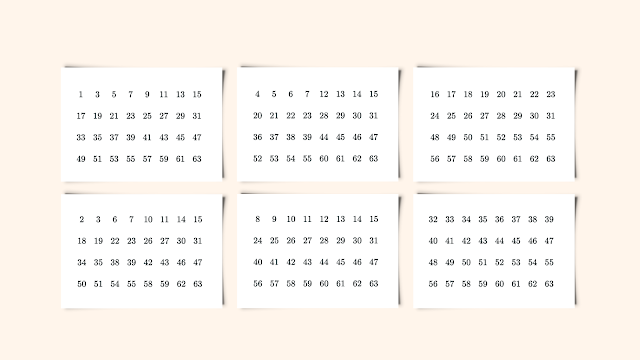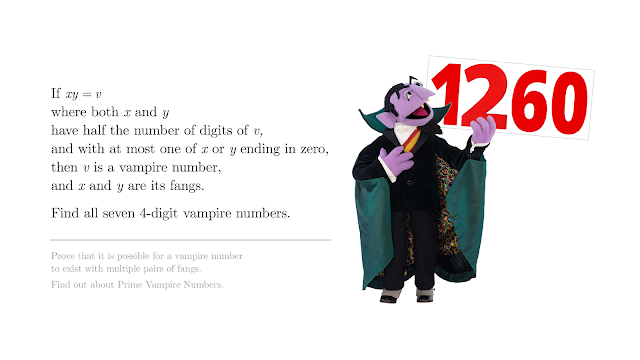For a maths teacher, 'The Mystery Calculator' is a potent conceit that piques students' interest and that — when used carefully[2] of course — levers and encourages strong, mathematically mature thinking. After playing the trick out on/with students, it is demystified carefully, and collectively, before students use their newfound knowledge and understanding creatively in devising a different trick, based on the same principles. (A ppt version of the cards, one card per slide, can be downloaded here.)
The Trick
- Ask someone to choose a number from any of the six cards.
- Show them each card in turn and ask them if their number appears on it.
- Add the numbers in the top left-hand corner of each card that contains their number.
- The total is their number.
The How / Why
The number 1 in binary is (1 x 2⁰) → (1)10 = (1)2 → Hence the number 1 appears on the 1st card only.
The number 2 in binary is 10... (1 x 2¹) + (0 x 2⁰) → (2)10 = (10)2 → Hence the number 2 appears on the 2nd card, but does not appear on the 1st or any other.
The number 3 in binary is 11... (1 x 2¹) + (1 x 2⁰) → (3)10 = (11)2 → Hence the number 3 appears on the first 2 cards, but does not appear on others.
The number 4 in binary is 100... (1 x 2²) + (0 x 2¹) + (0 x 2⁰) → (4)10 = (100)2 → Hence the number 4 appears on the 3rd card but does not appear on the 1st or 2nd, or any other.
The number 5 in binary is 101... (1 x 2²) + (0 x 2¹) + (1 x 2⁰) → (5)10 = (101)2 → Hence the number 5 appears on the 1st and 3rd cards, but does not appear on the 2nd, or any other.
The number 6 in binary is 110... (1 x 2²) + (1 x 2¹) + (0 x 2⁰) → (6)10 = (110)2 → Hence the number 6 appears on 2nd and 3rd cards but does not appear on the 1st, or any other.
The number 7 in binary is 111... (1 x 2²) + (1 x 2¹) + (1 x 2⁰) → (7)10 = (111)2 → Hence the number 7 appears on on 1st, 2nd and 3rd cards, but does not appear on any other.
⋮
The number 41 in binary is 101001... (1 x 2⁵) + (0 x 2⁴) + (1 x 2³) + (0 x 2²) + (0 x 2¹) + (1 x 2⁰) → (41)10 = (101001)2 → Hence the number 41 appears on the 1st, 4th and 6th cards but does not appear on the 2nd, 3rd or 5th.
⋮
The number 62 in binary is 111110... (1 x 2⁵) + (1 x 2⁴) + (1 x 2³) + (1 x 2²) + (1 x 2¹) + (0 x 2⁰) → (62)10 = (111110)2 → Hence the number 62 appears on the 2nd, 3rd, 4th, 5th and 6th cards, but does not appear on the 1st.
The number 63 in binary is 111111... (1 x 2⁵) + (1 x 2⁴) + (1 x 2³) + (1 x 2²) + (1 x 2¹) + (1 x 2⁰) → (63)10 = (111111)2 → Hence the number 63 appears on all six cards.
Thinking through some possible starting questions for students to consider (or to consider with students), before moving on perhaps with students creating their own 'Mystery Calculator' trick (see also [3]):
Notes & (Select) Links:
The number 1 in binary is (1 x 2⁰) → (1)10 = (1)2 → Hence the number 1 appears on the 1st card only.
The number 2 in binary is 10... (1 x 2¹) + (0 x 2⁰) → (2)10 = (10)2 → Hence the number 2 appears on the 2nd card, but does not appear on the 1st or any other.
The number 3 in binary is 11... (1 x 2¹) + (1 x 2⁰) → (3)10 = (11)2 → Hence the number 3 appears on the first 2 cards, but does not appear on others.
The number 4 in binary is 100... (1 x 2²) + (0 x 2¹) + (0 x 2⁰) → (4)10 = (100)2 → Hence the number 4 appears on the 3rd card but does not appear on the 1st or 2nd, or any other.
The number 5 in binary is 101... (1 x 2²) + (0 x 2¹) + (1 x 2⁰) → (5)10 = (101)2 → Hence the number 5 appears on the 1st and 3rd cards, but does not appear on the 2nd, or any other.
The number 6 in binary is 110... (1 x 2²) + (1 x 2¹) + (0 x 2⁰) → (6)10 = (110)2 → Hence the number 6 appears on 2nd and 3rd cards but does not appear on the 1st, or any other.
The number 7 in binary is 111... (1 x 2²) + (1 x 2¹) + (1 x 2⁰) → (7)10 = (111)2 → Hence the number 7 appears on on 1st, 2nd and 3rd cards, but does not appear on any other.
⋮
The number 41 in binary is 101001... (1 x 2⁵) + (0 x 2⁴) + (1 x 2³) + (0 x 2²) + (0 x 2¹) + (1 x 2⁰) → (41)10 = (101001)2 → Hence the number 41 appears on the 1st, 4th and 6th cards but does not appear on the 2nd, 3rd or 5th.
⋮
The number 62 in binary is 111110... (1 x 2⁵) + (1 x 2⁴) + (1 x 2³) + (1 x 2²) + (1 x 2¹) + (0 x 2⁰) → (62)10 = (111110)2 → Hence the number 62 appears on the 2nd, 3rd, 4th, 5th and 6th cards, but does not appear on the 1st.
The number 63 in binary is 111111... (1 x 2⁵) + (1 x 2⁴) + (1 x 2³) + (1 x 2²) + (1 x 2¹) + (1 x 2⁰) → (63)10 = (111111)2 → Hence the number 63 appears on all six cards.
Possible Teaching Approaches
- What do you notice about the numbers on each card?
- Do these patterns matter — what could we do to see if they do?
- Can we have a number larger than 63 on any of the cards?
- What about all of the other numbers on the cards — can they be chosen randomly?
- What number would appear on all cards if there were four, five, seven, ten, ... cards?
- Does the number in the top left-hand corner have to be there?
- Are there any constraints to the numbers we place on the cards?
- Would a similar trick in another base, maybe base-3, be more magical?
- How high can we count in binary on our fingers? (Watch this Ted-Ed video from James Tanton.)
Notes & (Select) Links:
[1] See here for an example, or here.
[2] See 'When Magic Fails in Mathematics,' by Junaid Mubeen.
[3] See this by Katie Steckles in The Aperiodical, 'On Disreputable numbers'.
For other Christmathsy problems to consider with students, try the 'Santamaths' problem, the '12 Days of Christmas' problem, see this selection from @mathsjem, and have a look at my 'xmaths card'.
[2] See 'When Magic Fails in Mathematics,' by Junaid Mubeen.
[3] See this by Katie Steckles in The Aperiodical, 'On Disreputable numbers'.
For other Christmathsy problems to consider with students, try the 'Santamaths' problem, the '12 Days of Christmas' problem, see this selection from @mathsjem, and have a look at my 'xmaths card'.



.png)


















